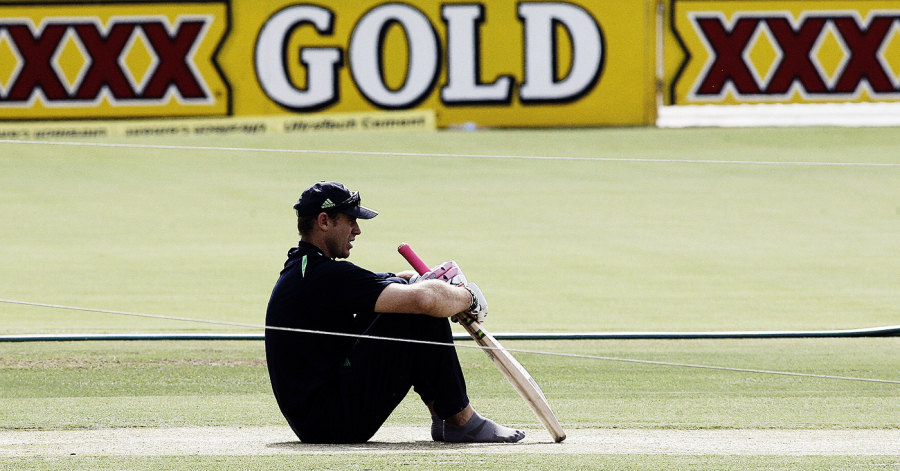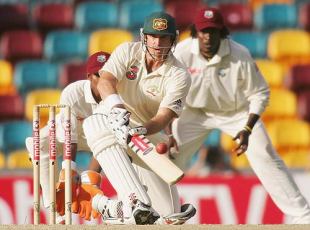'Walking down the track is such a rush'
Australia's long-serving opener on preparation, adapting to situations, playing the sweep, and putting the fear of God into bowlers
|
|

|
I go to the middle, I mark the crease and I squat on the wicket. I feel grounded when I do that. It's like a centring process. It's like, I'm out in this amazing place with millions across the world watching but right now I'm feeling very solid here. I don't say these things aloud but I just feel it every time I go out there. The middle of the cricket ground is the most comfortable place on earth for me.
The zone to me is pretty much every time I go out to bat. I never feel out of that. Not that it necessarily means there is a good result coming my way every time ...
I do lots of batting. I think I hit more balls than anyone else before a game. That's for two reasons: for my fitness and power, and for body position. I try and analyse bowlers and work out my strategies. That takes time. If there are five bowlers in an attack, I will analyse and commit serious time to each one of those bowlers.
I do it when the bowlers settle into a pattern of play where you think they are bowling very well. Walking down is a good way to unsettle play. It's really throwing out a challenge to them: I know you're bowling really well here, but I am not going to let you.
When I walk down, I just think: "I just want to see the ball, and wherever they bowl, I hit it there." (He laughs.) There's a tremendous adrenalin rush when you walk down the track.
| I get comments in streets: "Oh you look so massive on screen. But you look fine in real life, you know!" It's like an expectation that people have | |||
I find I am aggressive, and I think my size perhaps sort of gives that image too. I get comments in streets: "Oh you look so massive on screen. But you look fine in real life, you know!" It's like an expectation that people have. In my mind, in real life, as you can tell, I'm quite placid.
All my career I have always loved hitting the ball. Even before I started playing first-class, my intentions were always to score. I was a big, strong boy, you know, and my intentions were to look to score runs.
I never really got an opportunity, to be honest. Against South Africa the first time, I was in for Mark Taylor who was very, very solid in his position. So that was just an opportunity by chance of his misfortune rather than my success.
No, I felt I belonged but I just knew that for whatever reasons it wasn't my time. So I quietly accepted that and made an affirmation to myself to try and get better every day, learn more about my game so that the next opportunity - which I always believed was going to come - I would be a better cricketer, better team member and a better, more rounded person.
Yeah, that's right. As fine a cricketer as I am right now, I don't think as a young player I had it right. But having said that, momentum is an enormous thing in sport. The Donalds and Ambroses got a young Hayden - someone who had no momentum. You're starting from scratch. It's like building a business: you just don't strike rich straightaway. You've got to build steadily in a very organic way. Momentum in cricket is exactly the same. You gradually get to a position where you have a profile and expectation, and there is a reverse pressure as well - they know you are a fine player.
|
|

|
I think in 2000. We played West Indies; I was playing really well but I just had a run of no luck. I got run out a couple of times in the 40s and 50s, and I could feel that it was all starting to happen there.
I was really looking to come to India. I think I was savouring the Indian tour more than any other on earth. I prepared hard for that and sweeping was a strategy. I had a solid defensive strategy but what I came prepared to do was to have an attacking strategy with that sweep. It has been copied around the world now really. Most left-handers now look to play that sweep as a go-to shot to scoring.
The seed was planted in 1993, when I was working with Allan Border and Bob Simpson. Border was a very good sweeper as well and I got the foundation of it from him: understanding when and how, what lines to play, and picked his mind on that. Now it's changing again. It's reverse-sweeping! It's great. I just love the way people play the game now.
Yeah, idiotic wasn't it?! You know, I have never reverse-swept a seamer before in my life. It's too risky to practise because you can get hurt. It was just instinct. I just felt I knew where the ball would be, and as it turned out that's exactly where it was.
Magically often, I reckon. I don't know what it is, it's just experience.
Yeah, I do pick up cues early. For all of the bowlers, really. They have all got cues. You can tell from the field where they are supposed to bowl, but I just feel that I understand where the ball is going to be a lot. I think any batsman who rises to the top of his game in Test cricket understands that. It's not premeditation - it's just picking up the cues very well.
Yeah. They say in life keep your enemies close. The ball is something I like to keep close to me! On bouncy pitches in Australia, if you get further away from the ball there are more chances of nicking it. In subcontinental conditions I do a lot of work on getting away from the ball because you need to have the freedom of your arms to generate bat speed, whereas at home you need to get in line and hit it on to the line of the ball.
He is a very fine bowler and he has got me out a number of times, but yeah, I just feel comfortable facing him. But then I feel comfortable facing most people in the world.
| You go through these little patches where people understand your game. Then you reinvent yourself and go again. It takes time to do that, lots of energy and effort, but you have to do that to have any longevity in the game | |||
Yes. You are like a couple, you know. Like any couple, you go through good times and bad times but you're always there for each other. That's who we are. We just get each other. When you get someone, it's a really good feeling - you are so comfortable in that person's space. You know their life enough that when they or you are under pressure, you can talk about it, about anything. It's just a nice feeling. Walking out with Justin was a real treat and something I really savoured.
Not very much, I must say. I practise a lot and train a lot. But I feel training has got nothing to do with cricket - its just about my own fitness and for my enjoyment. I enjoy doing stuff outside cricket, like fishing and surfing. I love to cook. I love cultural experiences. I want to travel more and do some business stuff.
Sriram Veera is a staff writer at Cricinfo